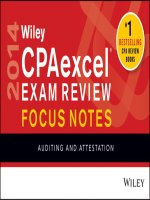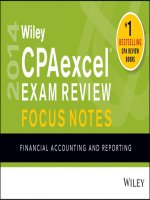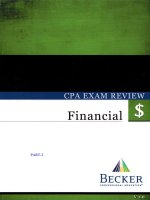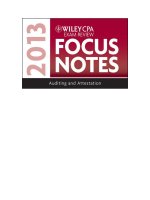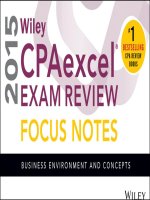Wiley CPA excel exam review 2016 focus notes regulation
Bạn đang xem bản rút gọn của tài liệu. Xem và tải ngay bản đầy đủ của tài liệu tại đây (2.18 MB, 291 trang )
2016
Wiley
CPAexcel
®
exam review
FOCUS NOTES
Regulation
Cover Design: Wiley
Cover image: © turtleteeth/iStockphoto
Copyright © 2016 by John Wiley & Sons, Inc. All rights reserved.
Published by John Wiley & Sons, Inc., Hoboken, New Jersey
Published simultaneously in Canada.
No part of this publication may be reproduced, stored in a retrieval system or transmitted in any form or by any means,
electronic, mechanical, photocopying, recording, scanning or otherwise, except as permitted under Section 107 or 108 of
the 1976 United States Copyright Act, without either the prior written permission of the Publisher, or authorization through
payment of the appropriate per-copy fee to the Copyright Clearance Center, Inc., 222 Rosewood Drive, Danvers, MA 01923,
978-750-8400, fax 978-750-4470, or on the Web at www.copyright.com. Requests to the Publisher for permission should be
addressed to the Permissions Department, John Wiley & Sons, Inc., 111 River Street, Hoboken, NJ 07030, 201-748-6011,
fax 201-748-6008, or online at />Limit of Liability/Disclaimer of Warranty: While the publisher and author have used their best efforts in preparing this book,
they make no representations or warranties with respect to the accuracy or completeness of the contents of this book and
specifically disclaim any implied warranties of merchantability or fitness for a particular purpose. No warranty may be created or
extended by sales representatives or written sales materials. The advice and strategies contained herein may not be suitable for
your situation. You should consult with a professional where appropriate. Neither the publisher nor author shall be liable
for any loss of profit or any other commercial damages, including but not limited to special, incidental, consequential, or other
damages.
For general information on our other products and services, or technical support, please contact our Customer Care Department
within the United States at 800-762-2974, outside the United States at 317-572-4002.
Wiley also publishes its books in a variety of electronic formats. Some content that appears in print may not be available in
electronic books. For more information about Wiley products, visit our Web site at .
ISBN: 978-1-119-12009-4 (paperback); 978-1-119-24093-8 (ebk); 978-1-119-24092-1 (ebk)
Printed in the United States of America
10 9 8 7 6 5 4 3 2 1
Contents
Prefacev
About the Author
vii
About the Contributors
vii
Module 23:
Module 24:
Module 25:
Module 26:
Module 27:
Module 28:
Module 29:
Module 30:
Module 31:
Module 32:
Module 33:
Module 34:
Module 35:
Professional and Legal Responsibilities
Federal Securities Acts
Business Structure
Contracts
Sales
Commercial Paper
Secured Transactions
Bankruptcy
Debtor-Creditor Relationships
Agency
Regulation of Business Employment, Environment, and Antitrust
Property
Individual Taxation
1
16
28
52
66
80
93
101
114
118
122
145
154
iii
Module 36:
Module 37:
Module 38:
Module 39:
Transactions in Property
Partnership Taxation
Corporate Taxation
Other Taxation Topics
208
215
224
253
Index276
Contents
iv
Preface
This publication is a comprehensive, yet simplified study program. It provides a review of all the
basic skills and concepts tested on the CPA exam, and teaches important strategies to take
the exam faster and more accurately. This tool allows you to take control of the CPA exam.
This simplified and focused approach to studying for the CPA exam can be used:
•
•
•
As a handy and convenient reference manual
To solve exam questions
To reinforce material being studied
Included is all of the information necessary to obtain a passing score on the CPA exam in
a concise and easy-to-use format. Due to the wide variety of information covered on the exam, a
number of techniques are included:
•
•
•
Acronyms and mnemonics to help candidates learn and remember a variety of rules and
checklists
Formulas and equations that simplify complex calculations required on the exam
Simplified outlines of key concepts without the details that encumber or distract from
learning the essential elements
v
•
•
•
Techniques that can be applied to problem solving or essay writing, such as preparing a
multiple-step income statement, determining who will prevail in a legal conflict, or developing an audit program
Pro forma statements, reports, and schedules that make it easy to prepare these items by
simply filling in the blanks
Proven techniques to help you become a smarter, sharper, and more accurate test taker
This publication may also be useful to university students enrolled in Intermediate, Advanced and
Cost Accounting; Auditing, Business Law, and Federal Income Tax classes; or Economics
and Finance classes.
Good luck on the exam,
Ray Whittington, PhD, CPA
Preface
vi
About the Author
Ray Whittington, PhD, CPA, CMA, CIA, is the dean of the Driehaus College of Business at DePaul University. Prior to
joining the faculty at DePaul, Professor Whittington was the Director of Accountancy at San Diego State University. From
1989 through 1991, he was the Director of Auditing Research for the American Institute of Certified Public Accountants
(AICPA), and he previously was on the audit staff of KPMG. He previously served as a member of the Auditing Standards
Board of the AICPA and as a member of the Accounting and Review Services Committee and the Board of Regents of
the Institute of Internal Auditors. Professor Whittington has published numerous textbooks, articles, monographs, and
continuing education courses.
About the Contributors
Edward C. Foth, PhD, CPA, Administrator of the Master of Science in Taxation Program at DePaul University. Professor
Foth is the author of CCH Incorporated’s Study Guide for Federal Tax Course, Study Guide for CCH Federal Taxation:
Comprehensive Topics, and coauthor of their S Corporation Guide. Professor Foth prepared the answer explanations
vii
to the multiple-choice and task-based simulation questions in Income Taxes, wrote new questions, selected the mix of
questions, and updated items to reflect revisions in the tax law.
Brad McDonald, JD, is an instructor of Business Law and Statistics at Northern Illinois University. He has taught
business law since 1987 and has taught the Business Law section of the Northern Illinois CPA review course since
1998. He wrote and revised most of the Business Law modules. He prepared and revised answer explanations for the
multiple-choice and simulation questions.
About the Contributors
viii
Regulation of Accountants
•
State boards of accountancy issue licenses to practice in a state
•
•
•
AICPA and state societies of CPAs
•
•
•
Investigate violations of professional ethics through Joint Ethics Enforcement Program
(JEEP)
May admonish, sanction, suspend, or expel a member
The AICPA Uniform Accountancy Act (UAA)
•
•
•
Investigate violations of professional standards and ethics
May revoke license to practice
Provides guidance to states in establishing accountancy laws
Contains rules for education, reciprocity, continuing education, etc.
The Securities Exchange Commission
•
•
Investigates CPAs and CPA firms that violate SEC rules
May disbar an accountant or firm from auditing public (issuer) companies
Focus on
Professional and Legal Responsibilities—Module 23
1
Regulation of Accountants (continued)
•
The Public Company Accounting Oversight Board (PCAOB)
•
•
•
•
Registers and performs inspections of firms that audit public (issuer) companies
Firms that audit more than 100 issuers are inspected every year
Firms that audit 100 or less issuers are inspected every three years
For substandard performance the PCAOB may:
•
•
Prescribe remedial actions such as improvements in quality control
Suspend an individual or firm from auditing issuers
Focus on
Professional and Legal Responsibilities—Module 23
2
Accountants’ Liability
Liability under Common Law
An accountant may be liable under common law due to negligence or fraud.
Negligence
A loss due to negligence occurs when an accountant violates the duty to perform professional
services in a competent manner. NEGligence may consist of
• Nondisclosure of information to a client
• Errors previously discovered not being corrected
• GAAP not being followed
Best defense to common law negligence is that appropriate professional standards were followed.
Focus on
Professional and Legal Responsibilities—Module 23
3
Negligence (continued)
Simple negligence
•
•
Careless mistakes
Defense of lack of privity may be available
•
•
•
But client and intended third-party beneficiaries have privity
Foreseen third parties have privity in majority of states under tort law
Foreseen third parties lack privity in states conforming to Ultramares case
Gross negligence
•
•
Reckless disregard for the truth
Lack of privity not valid as defense
Focus on
Professional and Legal Responsibilities—Module 23
4
Fraud
Fraud refers to conduct that involves all of the following:
Material false representation of fact
Justifiable reliance on the information
• Awareness of the false information by the accountant
• The falsity was made with the ultimate intent to deceive
• The party must have suffered damages
•
•
Scienter refers to the accountant’s knowledge of a false representation or material omission of
fact with the intent to deceive.
Potential defenses against fraud include:
•
•
Lack of intent to deceive
Immateriality
Lack of privity is not a valid defense.
Focus on
Professional and Legal Responsibilities—Module 23
5
Liability under Federal Securities Regulations
Auditors are liable under both the Securities Act of 1933 (33 Act) and the Securities Exchange Act
of 1934 (34 Act).
Liability under 33 Act
Accountants are liable under Section 11 of the 33 Act
• Liable if financial statements contain untrue statement or material omission
• Liable to anyone acquiring security without knowledge of error
To be successful, the plaintiff need not prove
•
•
•
Privity
Scienter
Reliance
Defenses the accountant may use include
•
•
Plaintiff’s knowledge of the error
Due diligence in performance of services
Focus on
Professional and Legal Responsibilities—Module 23
6
Liability under 34 Act
Accountants are liable under Rule 10b-5 of the 34 Act:
•
•
Liable for oral or written misrepresentations of fact
Liable for wrongful act committed through mail, interstate commerce, or a national securities
exchange
To be successful, the plaintiff must prove:
•
•
Scienter
Reliance
Defenses the accountant may use include:
•
•
Plaintiff’s knowledge of the error
Lack of reliance by plaintiff
Focus on
Professional and Legal Responsibilities—Module 23
7
Summary of Auditor Liability
Elements in action taken against an accountant
1)
2)
3)
4)
There is a misstatement or omission of a material fact
Plaintiff has reasonably relied upon the information
Plaintiff suffered a loss
Accountant was in error
Focus on
Professional and Legal Responsibilities—Module 23
8
Auditor Common Law Liability
Gross Negligence
or Fraud
Contracts
Negligence
Who may bring action
Client or an intended
user
Client or (usually)
foreseen user
Anyone injured
Accountant’s error
resulting in action
Breach of contract
Carelessness
Recklessness or intentional
misconduct (scienter)
Plaintiff must prove
All four elements
All four elements
All four elements
Focus on
Professional and Legal Responsibilities—Module 23
9
Auditor Liability under Federal Securities Laws
1933 Act Section 11
1934 Act Rule 10b-5
Who may bring action
Any purchaser
Any purchaser
Accountant’s error resulting
in action
Lack of due diligence
Recklessness or intentional
misconduct (scienter)
Plaintiff must prove
Elements 1 and 3 only
All four elements
Focus on
Professional and Legal Responsibilities—Module 23
10
Private Securities Litigation Reform Act of 1995
Requires auditor of publicly held company to include specific substantive procedures designed to
•
•
•
Identify illegal acts, including management fraud, having a direct and material effect on the
financial statements
Identify significant related-party transactions
Determine if there is substantial doubt related to the entity’s ability to continue as a going
concern
Illegal acts must be reported to management and board of directors must be notified
Board of directors must
•
•
Notify the SEC within 1 business day
Provide auditor with copy of report to SEC
If auditor not notified
•
•
Resign from engagement
Notify SEC within 1 business day of board’s failure to meet deadline
Focus on
Professional and Legal Responsibilities—Module 23
11
Private Securities Litigation Reform Act of 1995 (continued)
Responsibilities under the Sarbanes-Oxley Act
•
•
CPAs and CPA firms may be criminally prosecuted for destroying or falsifying records
(e.g., working papers)
Created the Public Company Accounting Oversight Board (PCAOB)
•
•
•
•
•
•
•
Public companies must disclose whether they have adopted code of ethics for company’s
officers
For audit committees of the board of directors
•
•
•
Registers CPA firms that audit public (issuer) companies
Sets standards on auditing, quality control, independence for registered CPA firms
Restricts the types of services that a CPA firm may perform for an issuer audit client
Requires rotation of audit partner every 5 years
Requires audits of internal control over financial reporting
All members must be independent
Must have at least one financial expert
Requires the CEO and CFO to certify to company’s financial statements
Focus on
Professional and Legal Responsibilities—Module 23
12
Standards for Tax Practice
AICPA Statements on Responsibilities for Tax Services
A CPA performing tax services
•
•
•
•
•
May not recommend a tax position that lacks merit
Must make a reasonable effort to answer applicable questions on the return
May rely on client information when preparing the return
Must make reasonable inquiries about questionable or incomplete information
May use estimates
Focus on
Professional and Legal Responsibilities—Module 23
13
Treasury Department Circular 203
Establishes requirements for practicing before the Internal Revenue Service (IRS)
•
•
•
•
•
•
•
•
•
•
Requires registration with the IRS
Accountant must promptly provide records and documents to the IRS unless the accountant
believes the information is privileged
If accountant becomes aware of error in filed tax return must notify client of error and
consequences of not filing an amended return
Accountant must exercise due diligence in preparing tax return
Accountant must not charge an unconscionable fee
Accountant must not negotiate or endorse a client’s government refund check
Accountant must possess adequate competence to perform an assignment
Accountants with responsibility for overseeing a tax practice must take adequate steps to
ensure compliance by all personnel
Accountant may rely on information obtained from client without verification but must make
additional inquiries if information appears incorrect, incomplete or inconsistent with the
facts
Accountants have additional responsibilities when providing written advice
Focus on
Professional and Legal Responsibilities—Module 23
14
Liability as a Tax Preparer
Penalties
Actions by an accountant preparing a client’s tax return can result in penalties
•
•
•
Not providing client with copy of return
Failing to sign return as a preparer
Endorsing and cashing client’s refund check
Liability to Client
Other actions may create a liability to a tax client
•
•
•
Failing to file a return timely
Not advising client of tax elections
Neglecting evaluation of joint versus separate returns
Focus on
Professional and Legal Responsibilities—Module 23
15




